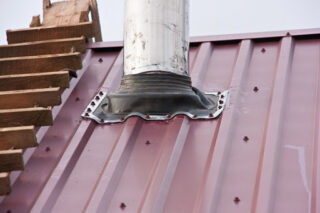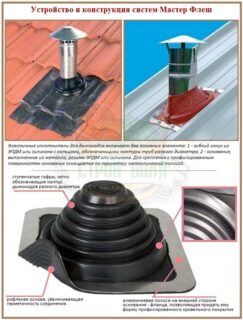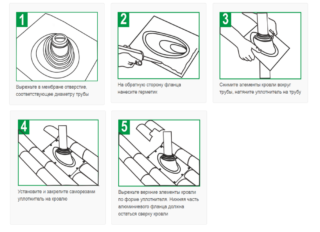The professional sheet is used for arranging the roof of residential buildings, summer cottages, baths, garages and many other types of buildings and structures. The material is distinguished by its presentable appearance, strength, durability, it is easy to lay it with your own hands. Craftsmen have to deal with the problem of sealing chimney passages through the flooring. An effective solution to this issue is the installation of a master flush on metal tiles. This device is also great for coatings such as ondulin and slate.
What is Master Flash

The Master Flash transit is a two-piece product made of sheet metal and an elastic truncated cone. The base is a plate of aluminum with a side up to 80 cm. The top is made in the form of a straight pyramid with protrusions in height. The connection of the parts is made by soldering and is absolutely sealed.
The principle of operation of the Master Flash penetration is to simultaneously press the flexible part against the pipe, and the rigid part against the roof surface. The elimination of the remaining gaps is carried out with a sealant, and the metal itself is tightly screwed to the flooring.
Advantages and disadvantages
Products have the following advantages:
- Tightness. The materials used are flexible and resilient. Provides a tight fit to the pipe and deck of any configuration.
- Elasticity. Products are suitable for slopes with any steepness, surface relief and material of protruding fragments.
- Strength. All components of the penetration correspond to the resistance to mechanical stress of the roof covering.
- Versatility. Parts can be equally successfully installed on smooth, corrugated and profiled coverings with all types of patterns. The scope of application is simply unlimited.
- Durability. The materials used in the manufacture are resistant to ultraviolet light, abrasives, and chemical reagents.
- Easy and quick installation. The whole procedure takes no more than 15 minutes in summer and an hour in winter, when it is required to clear the work area from snow. Detailed instructions for the product helps to do everything accurately and accurately.
- Quite affordable cost, similar to the costs of the kits that were used before.
When the temperature rises to a critical level, the flexible cone lights up. This imposes certain restrictions on the use of products.
Varieties and Choice of Master Flash
Cones are made from the following polymers:
- Rubber. Ethylene-propylene rubber, which belongs to the class of synthetic elastomers, has high elasticity, flexibility, and a high degree of protection against moisture. EDPM standard material has a porous structure, low thermal conductivity, resistance to fats and mineral oils. Such penetrations can be fixed on structures whose temperature does not exceed 100 degrees.
- Silicone. These seals are designed for higher temperatures and have a heating limit of 240 degrees. As it rises further, the material melts, but does not burn. As a minus, ultraviolet intolerance can be considered. With intense sunlight, silicone hardens over time, cracks and loses its tightness.
The plates are available in galvanized iron, stainless steel and aluminum. The pricing policy for each metal is different, but the performance indicators are also higher depending on the price.
Elastic tips are available in straight and inclined versions. The standard is 90, 30 and 45 degrees. At the same time, the pyramids are flexible and resilient enough to close pipes without any problems with a deviation of up to 20 degrees from the declared value.
At each level of the pyramid there is an inscription about the corresponding inner diameter. The master only needs to measure the size of the canal and cut off the excess with ordinary scissors. It should be borne in mind that the cross-section of the lining should be 20-25% smaller in order to ensure a tight and airtight abutment.
A sealant and self-tapping screws are purchased in the set for the penetration. It is necessary to take components that are resistant to the environment. Since the plate will still be painted over, the color does not matter. A silicone washer and a drill in front of the thread for self-tapping screws are required.
General installation principles
To carry out the installation of the penetration, you will need a very small set of tools that every owner has:
- screwdriver;
- mallet;
- glue gun;
- self-tapping screws;
- sealant;
- marker;
- knife or scissors.
Since you will have to work at a height, being also on an inclined surface, you need to think carefully about safety issues. Reliable insurance, helmet, goggles and gloves are required. A guard and warning signs should be posted below.
- Try on the plate on the roof. Apply its outline with a marker, taking 5-10 cm more in each direction.
- Prepare the surgical site. Remove debris, snow from the profiled sheet, clean the surface from moss, mold, rust, and other foreign substances.
- Carry out the same procedure for the exhaust duct. There should be no protruding parts on it. If there are sharp edges, they must be bent, cut or grinded.
- Carry out control measurements. Mark the location of the cut on the pyramid. Make sure once again that the calculation is correct and remove excess silicone.
- Remove the transport tape from the penetration. Clean the product from dust and crumbs.
- Lubricate the pipe with soapy water. Gently put the cap on its head, slowly lower it with scrolling to the level of the coating. Press down on the pyramid so that the plate presses on the flooring.
- Raise the base and set it in this position at a height of 40-50 cm from the surface.
- Apply a continuous layer of sealant inside the marked contour. Check that it is evenly distributed over the entire area.
- Place the plate in the lower position. If possible, push its upper edge under the cladding. Starting from the center, press it into the grooves of the coating. If the metal does not respond well, use a mallet.
- Attach the plate to the roofing material at intervals of 10 cm. Tighten tight, but not enough to squeeze the sealant out from underneath.
- Paint the penetration to match the color of the roof.
If the work is done correctly, the tunnel will regularly serve for at least 15 years, and its subsequent replacement will not cause much trouble.










